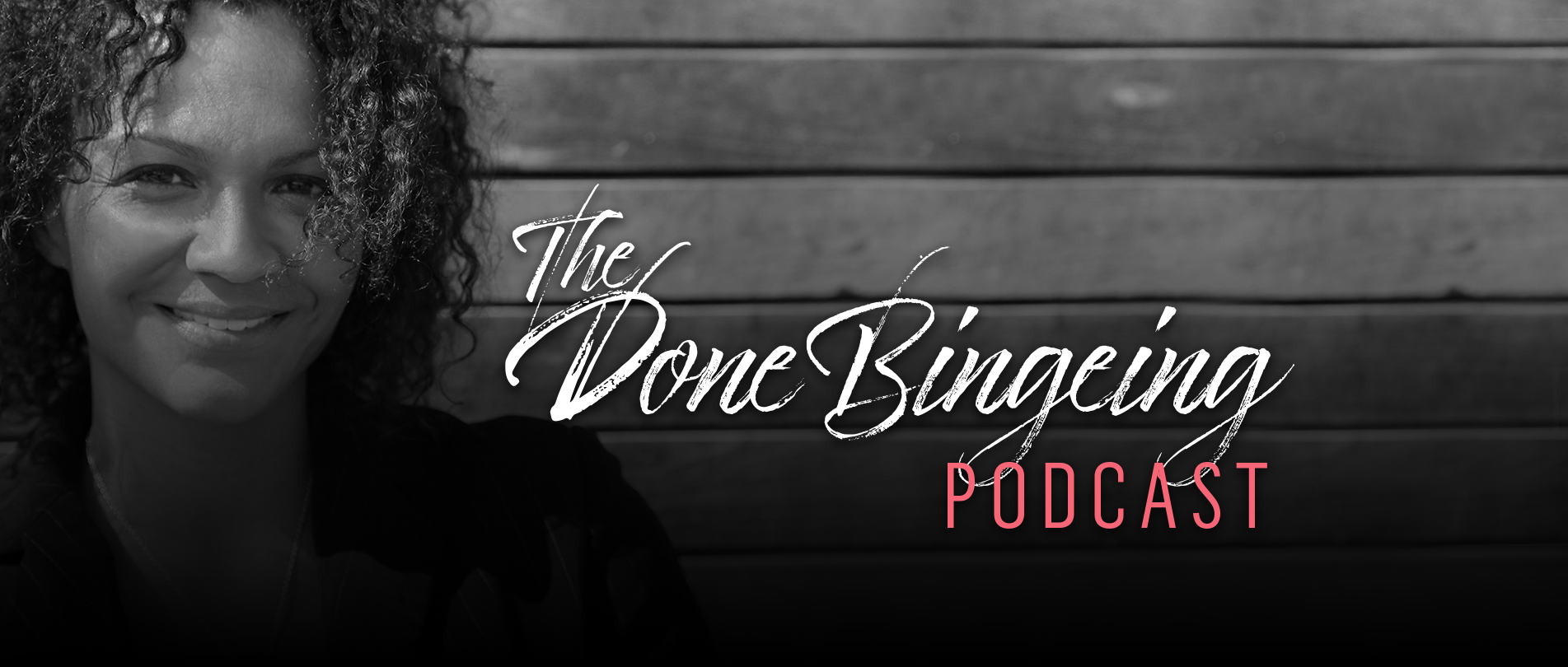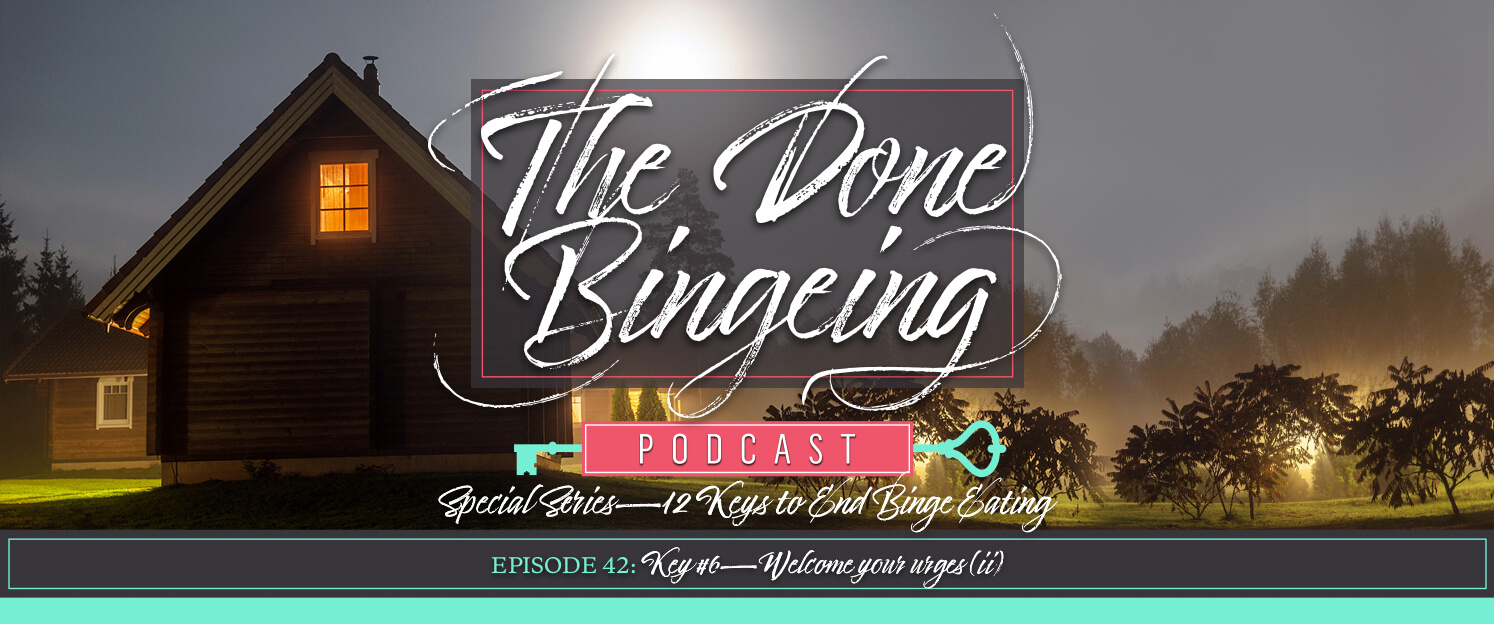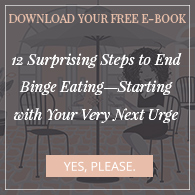
EP #42: Special series—12 keys to end binge eating, Key #6: Welcome your urges (ii)

This episode continues our discussion of the sixth key to end binge eating: Welcome your urges. We’re looking so closely at your urges because if you’re afraid of your them, you’ll be inclined to make them go away by bingeing. But what is it that we usually fear? We fear what we don’t know. So, I want to share strategies to get to know your urges in a way that makes them much less frightening. Listen in to the episode to find out more!
For a limited time, I’m teaching a free masterclass to dig deeper into the essential keys to ending binge eating. I’ll be coaching for free in the class too, so come with your questions ready! Reserve your spot at http://www.holdingthespace.co/masterclass/.
Get full show notes and more information here: https://www.holdingthespace.co/42
Episode: Play in new window
Subscribe: iTunes | Google Play | Stitcher | RSS
- Why you should not only welcome your urges but also look forward to them.
- Why you fear your urge so much.
- How to create an initial sense of safety about sitting with an urge.
- Four questions to ask yourself about your urges.
- Reserve your spot in a limited-time-only masterclass to dig deeper into the essential keys to ending binge eating and to get free live coaching.
- Join the Done Bingeing Group Coaching Program before it sells out!
What do a toddler, a visitor, and the boogeyman have to do with your urges? Keep listening!
Welcome to The Done Bingeing Podcast. This is the place to hear about how you can pair the emerging brain science about why you binge with powerful life coaching to help you stop. If you want to explore a non-clinical approach to end binge eating, you’re in the right place. It’s time to free yourself. You have more power than you know. And now, your host, Life and Weight-Loss Coach Martha Ayim.
Welcome to Episode 42 of The Done Bingeing Podcast and to part 8 of this special series, 12 Keys to End Binge Eating. This episode continues our discussion of the sixth key: Welcome Your Urges.
I have to tell you guys that I expected this special series on these 12 keys to just be an episode or two. And pretty much all of the episodes I recorded before the special series even began, I thought I’d be able to summarize in the first episode.
But what I’ve found is that so many of you have reached out to me and let me know that you want more detail, that you listen and sometimes re-listen, that you take notes and often do the exercises I recommend. And I’ve been so privileged by all that you share with me, whether in your podcast reviews, in my masterclass, in emails, or in free sessions. And I’ve wanted to honor that by sharing the best of what I know in as much detail as I can in these episodes. So, I hope you can forgive me if it seems like I get a little long winded at times!
As someone who no longer binges, I’m so passionate about helping you stop bingeing too. And as much as I try to create truly helpful content, there’s only so much I can do in my podcast and in my masterclass. I would love to help you apply these concepts at a much deeper level so you can end this pattern of eating, so you can live fully instead of partially, so you can act in alignment with what you really want, so you can become who you were meant to be, so that you can offer all that you have to you and to the world.
As far as I know, we get one life. Possible more, but I’m not privy to a definitive answer on that. I want you to live yours with all you’ve got. I created my group coaching program to offer coaching at a lower price point, so that it was more accessible to more people. You get live coaching from me and electronic access to me 24/7 for 10 weeks. You get tools and resources not available anywhere else. I want you to join us because I want you to be free from bingeing and overeating. So, if you want to be free, too, then sign up now before the group is full! You can reserve your spot at www.holdingthespace.co/group-programs/. I can’t wait to meet you in my members’ only space where we’re going to do the deep work together to get this monkey off your back.
Okay, so let’s get back to these 12 keys. We’ve been working on zooming out and zooming in to look at your urges from these two vantage points. Last week we zoomed out and reviewed the neuroscientific explanation of what’s happening in your brain when you get an urge to binge and binge to make it go away. Then we began the work of zooming in for a closer look at the urge.
The reason we’re looking so closely at your urges is because if you’re afraid of your them, you’ll be inclined to make them go away by bingeing.
But what is it that we usually fear? Before you answer, let me tell you a story.
When I was a little girl, I went through a phase where I’d ask my mom to check in my closet and under my bed for the boogeyman.
After Mom had checked, she’d show me that there were just my clothes and laundry hamper in my closet, and just a few books and slippers under my bed.
So, let me ask you that question again: What is it that we usually fear?
We fear what we don’t know.
I didn’t want to go into my room—and I for sure didn’t want to lie down in my bed and close my eyes in the pitch dark—until I’d gotten the all-clear from Mom that no one and nothing was lying in wait for me.
I didn’t know if the boogeyman was hiding in my closet or not. I didn’t know if the boogeyman was hiding under my bed or not. And that not knowing was enough to scare me out of wanting to go to bed no matter how tired I was.
But once I knew that no one was there, I could lie down. I didn’t love the dark, but I could deal with it and eventually trust enough to close my eyes.
Mom helped me to learn that if I looked, I could assess what was really there instead of fearing what wasn’t there at all.
Now, I have to say that my nervousness of my room at night wasn’t helped by the fact that once or twice, or maybe more, my brother hid under my bed and jumped out and screamed “Boo!”
But even then, Mom helped me to see—after shooing my brother away with a wag of her finger—that he was just a giggling 12-year-old boy who wanted to play a prank, not someone who really wanted to hurt me.
We want to look at the urge for similar reasons and in a similar way. We want to look at the urge because our fear of it means that we can’t face it as we need to. And we want to look at it from a place of safety.
Mom gave me that sense of safety, and eventually I was able to check in my closet and under my bed on my own.
How can you get a sense of safety with the urge?
Well, maybe by believing that it can’t actually kill you, no matter how awful it may feel.
Maybe by remembering that others have allowed the urge to visit and stay as long as it wanted and they survived.
Maybe by remembering that others, and perhaps you at times, have sat with the urge and realized it was far less scary than imagined.
Maybe by remembering that you are not alone, that you have me with you on this journey to help guide you in any way I can.
Maybe by knowing that there is a process for experiencing an urge that makes it much less scary.
And that’s what we’re going to talk for the rest of this episode.
I invite you to ponder these four questions:
- How would you describe your urge’s character or personality?
- How does your urge manifest as sensations in your body?
- How does the intensity of your urge change over time?
- How long does your urge last?
Let’s take these one at a time.
First, how would you describe your urge as a character or personality? Many of my clients have found it helpful to try to personify and capture a clearer sense of their urge, almost as if they had to sketch out a scene or cast a role for their urge in a screenplay.
For me, my urges were like a storm. Sometimes they swept in from nowhere. Sometimes they built continually from that first sign—the faintest wisp of air that gently nudged a tumbleweed, then gradually grew into a breeze that rolled that tumbleweed, then soon was a swoosh that sent the tumbleweeds racing ahead of me, and finally was a gust that almost blew me over.
One of my clients described her urge as an old friend who’d become her companion as a girl. Her friend had kept her company and helped her cope with the trauma she experienced in her childhood. But then, gradually, over the years, what had been her friend become her monster—a bully that waited in the corner until she was weak.
Another client described her urge as a toddler at the grocery store checkout who eyed the neat rows candy bars. Before she knows it, her urge is down on the floor screaming, kicking, banging its fists, and ordering her to give her chocolate bars or else! Or else what? Or else she’ll never, ever, ever stop wailing, not matter how many people are watching.
Describing the character of your urge does a few things.
It helps put some space between you and your urge so that you don’t see the urge as you. Your urge is something at a distance from you that you can then observe.
Understanding your urge’s character also helps you to recognize its signs and possibly even its triggers earlier.
And it can sometimes help you to change your perspective on the urge. Instead of being an undefined blob of terror, it might become a specific curiosity, possibly even a source of some humor.
Now, let me ask you something: Although bullies and toddlers are very different in many ways, what do we know to be common to them both?
Well, for starters, both want attention, both want a reaction from you. But why is that?
Here’s why:
Because, at the core of their drama, is the fact that they feel threatened by their lack of true power. And they act out to try to get it.
If a bully had real friends, he or she wouldn’t need to terrorize you.
If a toddler had real independence, he or she wouldn’t need you to buy them anything.
A bully seeks a reward: the satisfaction of upsetting you—that gives the bully a momentary sense of connection and supremacy.
A toddler also seeks a reward: the granting of their wish—that gives the toddler a momentary sense of control and authority.
But what happens if you give the bully and the toddler what they want? You encourage their goading, you feed their desire, you embolden them to come back for more.
But what happens if you don’t give the bully and the toddler what they want? (Now I don’t mean don’t feed the toddler food when they’re hungry! That’s not what I’m talking about. I’m talking about the kid at the grocery store checkout having a tantrum when they look at the rows and rows of beautifully colored candy bars.) Well, here’s what happens if you don’t give the toddler and the bully what they want: You’ll probably have to put up with them upping the ante for a while.
But if you persist, what happens next?
For the bully and the toddler, their provoking won’t be answered in a way that satisfies them. And soon they’ll get bored and lose interest in a ploy that no longer works.
For you, you get relief from the poking. And you gain the knowledge that you have the strength to face up to both, possibly afraid, possibly embarrassed, but to show up none-the-less and not give in.
When you don’t give in, you discourage the inclination of the bully and the toddler to push you around and they eventually stop.
The same goes for your urges. When you don’t answer your urge with a binge, you stop rewarding the urge, and in time, it goes away.
You disarm the bully, the toddler, and the urge in the same way: by doing the opposite of what they want you to do—that is, by standing your ground.
When you don’t panic and binge the urge away, when you instead relax and let the urge in, welcome it and observe it, you strip it of its power.
In behavioral therapy terms, you’re reducing or eliminating the undesirable behavior of bingeing. The urge to binge has been conditioned to keep coming because it’s been reinforced with the reward of the binge. And so, the way to extinguish the urge is to stop rewarding it with a binge.
When you are able to allow the urge without resisting it, reacting to it, or complying with it, it eventually extinguishes itself.
Just like the bully learns that the taunting doesn’t bring the reward of a reaction and just like the toddler learns that throwing a tantrum doesn’t bring the reward of the candy, the urge learns that its frantic signal doesn’t bring the reward of the binge.
And so the taunts, the tantrums, and the urges get extinguished. The more you can allow an urge without rewarding it, the less influence it will have over you and the less meaning it will have in your life.
At some point in our lives, we probably learned to binge as a way to cope with something. Maybe that something was a restrictive diet or a difficult life event.
But you may have other resources now and you may know that you know longer need to binge to cope.
Or you may not yet have those other resources, but you may still know that you need to learn them because the negative outcomes of your bingeing now far outweigh any positive outcomes the bingeing once offered.
If you’re still with me, and willing to open that door to the urge, here’s the second question I invite you to ponder: How does my urge manifest as a collection of physical sensations in my body? For example, is it a restlessness in my legs, a tightness in my throat, a tension in my shoulders, a hollow feeling in my belly? The urge is experienced differently by different people, and sometimes it’s different from one urge to another.
The third question I want you to think about is this: How does the intensity of my urge change over time? If on a scale from 0 to 10, where 0 equals no urge and 10 equals the most intense urge that for sure has you bingeing, where are you on that scale from one minute to the next? You may be surprised to find out that you’re not always at a 10 out of 10. In fact, many of my clients say that the moment they put their attention on gauging the intensity of their urge, the intensity drops by at least a notch.
Why is that, you may wonder. It’s because you’ve now moved away from the urge being you to the urge being the subject of your objective attention. There is now distance between you and the urge, and with that distance the power of the urge begins to diminish.
The fourth question I want you to ask yourself is this: How long did my urge last? When I first start working with clients, many of them will tell me, “Forever!” But then when they pay attention, they notice that the longest an urge tends to last is about 20 minutes. There are some exceptions, but generally that’s about the limit. And many find that most urges are actually much shorter and only last about a minute or two.
Now why is all of this good to know?
Here’s why: Because when you understand your urge’s personality, how urges feel in your body, how their intensity changes over time, and how long they last, you get to ask yourself another—very specific—question: Am I willing to welcome varying degrees of restless legs, tense shoulders, a tight throat, and a hollow belly for between two and twenty minutes—whether in the guise of a storm, a bully, or a kid—especially if it means that every time I say yes to that question, my urges will dissipate and eventually go away?
Now that’s a question worth asking. And I want you to give yourself the gift of an answer.
The next time an urge comes knocking, I invite you to open the door. But I’m not done yet, I want you to consider going further than just welcoming your urge in. I want you to look forward to its arrival.
I don’t want you feeling powerless and hoping it never comes back.
I want you feeling empowered enough to hope that it does.
Why on earth would I want such a thing for you? Because, for as long as you’re binging, your urges are your best ticket out. You need your urge to fix your bingeing. You need this signal so that you can train your brain to respond to it differently. Each time you get an urge, and you deliberately welcome it in and let it stay for a long as it intends, you wire one whole loop in your brain away from the bingeing. You help to strengthen a new neural connection anchoring a way of eating that you really want to have in your life. When you look at it this way, your urges are actually a gift.
Now, when I’m asking you to welcome an urge—to look forward to it even—am I saying that your urges will be comfortable? No. I’m not saying that.
The poet Rumi, in his poem The Guest House, says it better than I ever could:
This being human is a guest house.
Every morning a new arrival.
A joy, a depression, a meanness,
some momentary awareness comes
as an unexpected visitor.
Welcome and entertain them all!
Even if they are a crowd of sorrows,
who violently sweep your house
empty of its furniture,
still, treat each guest honorably.
He may be clearing you out
for some new delight.
The dark thought, the shame, the malice,
meet them at the door laughing and invite them in.
Be grateful for whatever comes,
because each has been sent
as a guide from beyond.
—Jellaludin Rumi, translation by Coleman Barks
Your urge may be your guide to show you that it is not as daunting as it seems.
Your urge may be your guide to show you that, even if does bring its own brand of sorrow, you can meet that sorrow.
We are called to open the door, to honor the guest, to risk the visit.
What we want to push away may actually hold the secret that brings us closer to what we seek.
That’s it for Episode 42. Thank you for listening. For a limited time, I’m teaching a free masterclass to dig deeper into the essential steps to ending binge eating. This masterclass is a chance to learn and to get free coaching from me. Reserve your spot at www.holdingthespace.co/masterclass/!
Thanks for listening to The Done Bingeing Podcast. Martha is a certified life and weight loss coach who’s available to help you stop bingeing. Book a free session with her at www.holdingthespace.co/book. And stay tuned for next week’s episode on freeing yourself from binge eating and creating the life you want.
Reference
Rumi, J. (tr. Barks, C.). (n.d.). The Guest House. Available: https://allpoetry.com/poem/8534703-The-Guest-House-by-Mewlana-Jalaluddin-Rumi
- Never miss an episode by subscribing via iTunes, Stitcher, Google Play, or RSS.
- Leave a rating and review in iTunes.
- Have a question or topic you’d like to see covered on the podcast? Send it on over to support@holdingthespace.co.
- If you found this episode valuable, it would mean so much to me if you would please share it with your friends.
- Ask yourself what you’d need to believe to give yourself a sense of safety with the urge. Would it help if you believed that the urge can’t actually kill you, no matter how awful it may feel? Would it help if you remember that others have allowed the urge to visit and stay as long as it wanted and they survived? Would it help if you remembered that others, and perhaps you at times, have sat with the urge and realized it was far less scary than imagined? Would it help if you remembered that you are not alone, that you have me with you on this journey to help guide you in any way I can? Would it help if you trusted that the next four questions offer a process for experiencing an urge that makes it much less scary? If not of these would help ease your fear around the urge. Ask yourself what would.
- How would you describe your urge’s character or personality?
- How does your urge manifest as sensations in your body?
- How does the intensity of your urge change over time?
- How long does your urge last?
Thank you so much for sharing your thoughts with me.
Sending much love to you!






















0 Comments